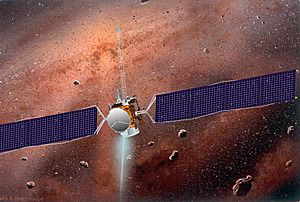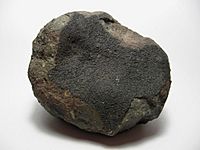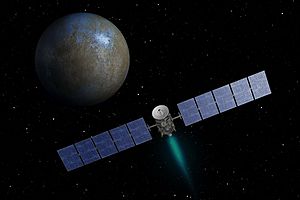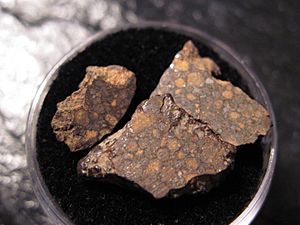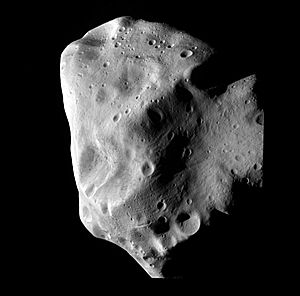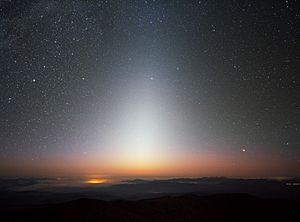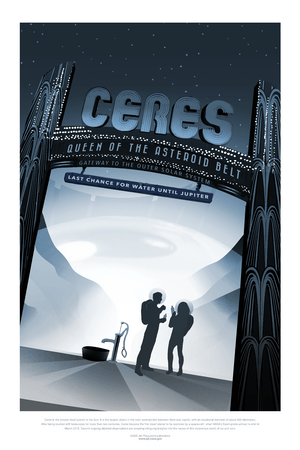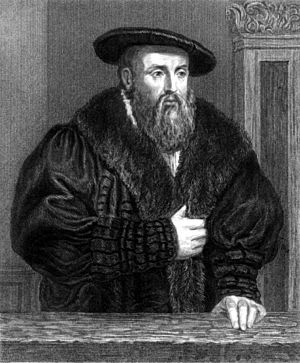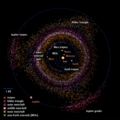Asteroid belt facts for kids
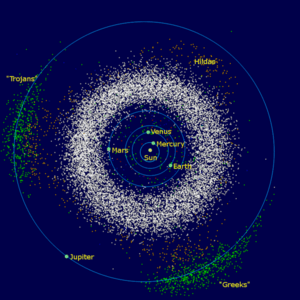
| Sun Jupiter trojans Orbits of planets |
Asteroid belt Hilda asteroids (Hildas) Near-Earth objects (selection) |
The asteroid belt is the circumstellar disc in the Solar System located roughly between the orbits of the planets Mars and Jupiter. The asteroid belt is also termed the main asteroid belt or main belt to distinguish it from other asteroid populations in the Solar System.
It is occupied by numerous irregularly shaped bodies called asteroids or minor planets. They are not visible from Earth with the naked eye, but many may be seen through binoculars or small telescopes.
Contents
Formation
The asteroids are not samples of the primordial Solar System. They have undergone considerable evolution since their formation, including internal heating (in the first few tens of millions of years), surface melting from impacts, space weathering from radiation, and bombardment by micrometeorites.
The asteroid belt formed from the primordial solar nebula as a group of planetesimals. Planetesimals are the smaller ancestors of the protoplanets.
Between Mars and Jupiter, gravitational resistance from Jupiter saturated the protoplanets with too much orbital energy for them to accrete into a planet. Collisions became too violent, and instead of fusing together, the planetesimals and most of the protoplanets shattered.
As a result, 99.9% of the asteroid belt's original mass was lost in the first 100 million years of the Solar System's history. Some fragments eventually found their way into the inner Solar System, leading to meteorite impacts with the inner planets. As of 2018, a study was released from researchers at the University of Florida that found the asteroid belt was created from the remnants of several ancient planets.
Characteristics
Contrary to popular imagery, the asteroid belt is mostly empty. The asteroids are spread over such a large volume that it would be doubtful to reach an asteroid without aiming carefully. Nonetheless, hundreds of thousands of asteroids are currently known, and the total number ranges in the millions or more. Over 200 asteroids are known to be larger than 100 km, and a survey has shown that the asteroid belt has between 700,000 and 1.7 million asteroids with a diameter of 1 km or more.
Over 96,000 asteroids have been given numbers. Almost 12,000 of them have names. Today, names for asteroids can be suggested by the people who discover them. Because so many asteroids are now being found, most new asteroid discoveries are not even getting a name at all, but rather a numbered code.
The total mass of the asteroid belt is estimated to be just 4% of the mass of the Moon. The four largest objects, Ceres, 4 Vesta, 2 Pallas, and 10 Hygiea, account for half of the belt's total mass, with almost one-third accounted for by Ceres alone.
Ceres, the asteroid belt's only dwarf planet, is about 950 km in diameter, whereas Vesta, Pallas, and Hygiea have mean diameters of less than 600 km. On 22 January 2014, ESA scientists reported the detection, for the first definitive time, of water vapor on Ceres, the largest object in the asteroid belt.
The remaining bodies range down to the size of a dust particle. The asteroid material is so thinly distributed that numerous unmanned spacecraft have traversed it without incident. Nonetheless, collisions between large asteroids do occur, and these can produce an asteroid family whose members have similar orbital characteristics and compositions.
The temperature of the asteroid belt varies with the distance from the Sun. For dust particles within the belt, typical temperatures range from 200 K (−73 °C) at 2.2 AU down to 165 K (−108 °C) at 3.2 AU. However, due to rotation, the surface temperature of an asteroid can vary considerably as the sides are alternately exposed to solar radiation and then to the stellar background.
Composition
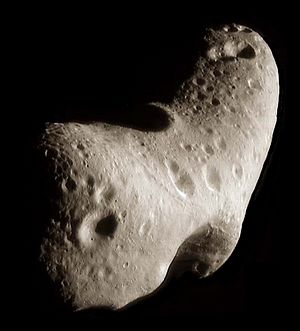
The current belt consists primarily of three categories of asteroids: C-type or carbonaceous asteroids, S-type or silicate asteroids, and M-type or metallic asteroids:
- Carbonaceous asteroids, as their name suggests, are carbon-rich. They dominate the asteroid belt's outer regions. Together they comprise over 75% of the visible asteroids. They are redder in hue than the other asteroids and have a very low albedo. Their surface composition is similar to carbonaceous chondrite meteorites.
- S-type (silicate-rich) asteroids are more common toward the inner region of the belt. Their surfaces reveal the presence of silicates and some metal, but no significant carbonaceous compounds. This indicates that their materials have been significantly modified from their primordial composition, probably through melting and reformation. They form about 17% of the total asteroid population.
- M-type (metal-rich) asteroids form about 10% of the total population; they contain elements that resemble that of iron-nickel.
Three out of four asteroids are made of rock that is rich in carbon. The rest are made of the metals iron and nickel. About half of these are pure iron and nickel; the rest are mixed with compounds of silica, the element that makes up rocks. Each of the larger metal asteroids contains huge amounts of iron: much more than is mined every year on Earth. Vesta, the brightest asteroid, has a very unusual composition - being made of high-density volcanic rocks.
Scientists are very interested in what asteroids are made of because it can help them learn how the solar system was formed. Several spacecraft have visited asteroids to learn more about them.
Collisions
The high population of the asteroid belt makes for a very active environment, where collisions between asteroids occur frequently (on astronomical time scales). Collisions between main-belt bodies with a radius of 10 km are expected to occur about once every 10 million years.
A collision may fragment an asteroid into numerous smaller pieces (leading to the formation of a new asteroid family). Collisions that occur at low speeds may also join two asteroids. After more than 4 billion years of such processes, the members of the asteroid belt now bear little resemblance to the original population.
Along with the asteroid bodies, the asteroid belt also contains bands of dust with sizes up up to a few hundred micrometres. This fine material is produced in part, from collisions between asteroids, and by the impact of micrometeorites upon the asteroids. Due to the the pressure of solar radiation this causes the dust to slowly spiral inward toward the Sun.
Some of the debris from collisions can form meteoroids that enter the Earth's atmosphere. Of the 50,000 meteorites found on Earth to date, 99.8 percent are believed to have originated in the asteroid belt.
Exploration
The first spacecraft to traverse the asteroid belt was Pioneer 10, which entered the region on 16 July 1972. At the time there was some concern that the debris in the belt would pose a hazard to the spacecraft, but it has since been safely traveled by 12 spacecraft without incident. Pioneer 11, Voyagers 1 and 2 and Ulysses passed through the belt without imaging any asteroids. On its way to Jupiter, Juno traversed the asteroid belt. Due to the low density of materials within the belt, the odds of a probe running into an asteroid are now estimated at less than 1 in 1 billion.
Galileo imaged Gaspra in 1991 and Ida in 1993, NEAR imaged Mathilde in 1997 and landed on 433 Eros in February 2001, Cassini imaged Masursky in 2000, Stardust imaged Annefrank in 2002, New Horizons imaged APL in 2006, Rosetta imaged Šteins in September 2008 and Lutetia in July 2010.
Most belt asteroids imaged to date have come from brief flyby opportunities by probes headed for other targets. Only the Dawn, NEAR and Hayabusa missions have studied asteroids for a period in orbit and at the surface. The Dawn orbited Vesta between July 2011 and September 2012 and has orbited Ceres since March 2015.
History of observation
In 1596, Johannes Kepler predicted a planet between Mars and Jupiter in his Mysterium Cosmographicum. While analyzing Tycho Brahe's data, Kepler thought that there was too large a gap between the orbits of Mars and Jupiter. When William Herschel discovered Uranus in 1781 it lead astronomers to conclude that there had to be a planet between the orbits of Mars and Jupiter.
On January 1, 1801, Giuseppe Piazzi, at the University of Palermo, Sicily, found a tiny moving object in an orbit. He dubbed it "Ceres", after the Roman goddess. Piazzi initially believed it to be a comet. It is the largest object in the asteroid belt. For several decades after its discovery, Ceres was known as a planet, after which it was reclassified as an asteroid. In 2006, it was designated as a dwarf planet.
Fifteen months later, Heinrich Olbers discovered a second object in the same region, Pallas. Apart from their rapid movement, they appeared indistinguishable from stars. By 1807, further investigation revealed two new objects in the region: Juno and Vesta, these are classified as asteroids.
The expression "asteroid belt" came into use in the very early 1850s. One hundred asteroids had been located by mid-1868, and in 1891 the introduction of astrophotography accelerated the rate of discovery still further. A total of 1,000 asteroids had been found by 1921, 10,000 by 1981, and 100,000 by 2000. Modern asteroid survey systems now use automated means to locate new minor planets in ever-increasing quantities.
Images for kids
-
Johannes Kepler noticed in 1596 irregularities in the orbits of Mars and Jupiter, which were later explained by the gravity from the asteroids.
-
Giuseppe Piazzi, discoverer of Ceres, the largest object in the asteroid belt: Ceres was known as a planet, but later reclassified as an asteroid and from 2006 as a dwarf planet.
-
Hubble views extraordinary multi-tailed asteroid P/2013 P5.
-
Overview of the Inner Solar System asteroids up to the Jovian System.
See also
 In Spanish: Cinturón de asteroides para niños
In Spanish: Cinturón de asteroides para niños



